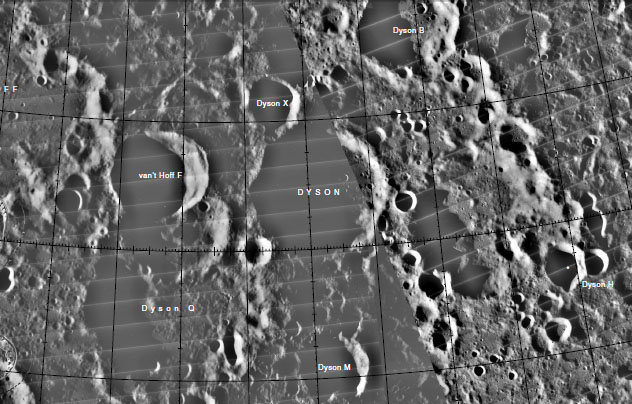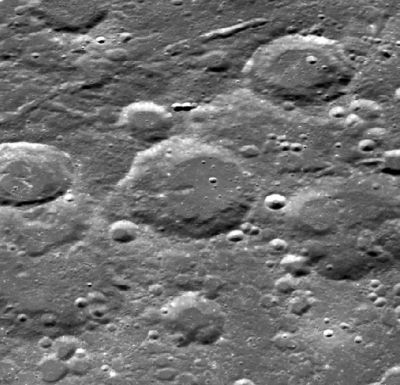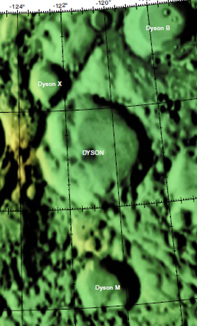Dyson
Contents
Dyson
|
Lat: 61.3°N, Long: 121.2°W, Diam: 63 km, Depth: km, Rükl: (farside) [/Stratigraphy Nectarian] | |
Table of Contents
[#Dyson Dyson]
[#Dyson-Images Images]
[#Dyson-Maps Maps]
[#Dyson-Description Description]
[#Dyson-Description: Wikipedia Description: Wikipedia]
[#Dyson-Additional Information Additional Information]
[#Dyson-Nomenclature Nomenclature]
[#Dyson-Lettered Craters Lettered Craters]
[#Dyson-LPOD Articles LPOD Articles]
[#Dyson-Bibliography Bibliography]
[#Dyson-Sir Frank Watson Dyson in the Sourcebook Project (William R. Corliss) Sir Frank Watson Dyson in the Sourcebook Project (William R. Corliss)]
Images
LPOD Photo Gallery Lunar Orbiter Images Apollo Images
Maps
([/LAC%20zone LAC zone] 20B1) USGS Digital Atlas PDF
Description
Description: Wikipedia
Additional Information
Nomenclature
- Named for Sir Frank Watson Dyson (1868-1939), a British astronomer. In addition to being Astronomer Royal (of England) from 1910 to 1933, Dyson was President of the IAU's Commission 17 (Lunar Nomenclature) at the time [/Named%20Lunar%20Formations Named Lunar Formations] was published (1935).
- Mount Dyson was [/Wilkins%20300-inch%20Map%20Names H. P. Wilkins]'s unofficial name for [/Pytheas Pytheas] Beta, a small hillock in [/Mare%20Imbrium Mare Imbrium].
Lettered Craters

Excerpt from the USGS Digital Atlas of the Moon.
LPOD Articles
Bibliography
Sir Frank Watson Dyson in the Sourcebook Project (William R. Corliss)
- In Mysterious Universe, a handbook of astronomical anomalies (1979) :
- Page 674: The Einstein Shift - an unsettled problem (F.Schmeidler, Sky and Telescope, 1964).
Note: another Dyson (or perhaps the same?) is mentioned on page 633, in the article How Special is the Universe? (P.C.W.Davies, Nature, 1974).
This page has been edited 1 times. The last modification was made by - tychocrater tychocrater on Jun 13, 2009 3:24 pm - afx3u2

